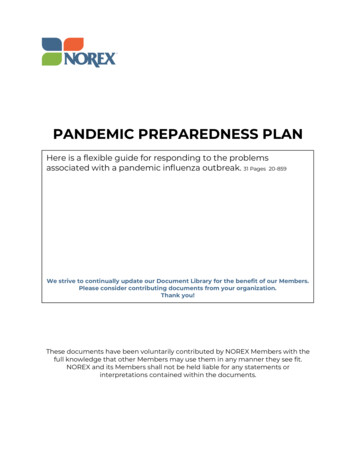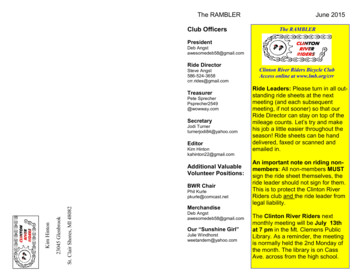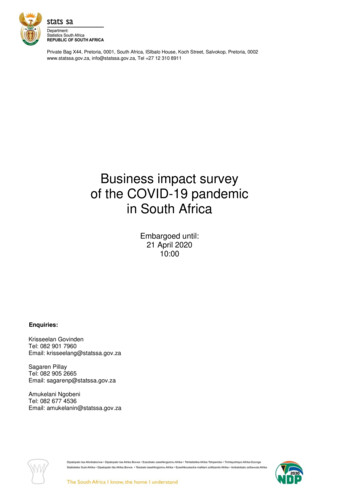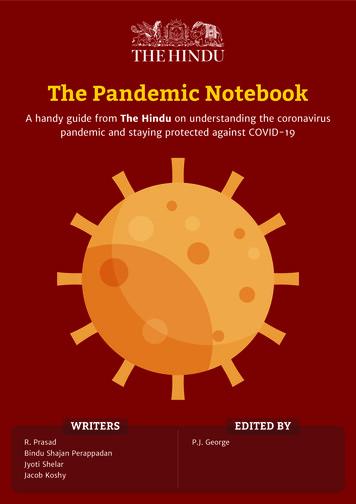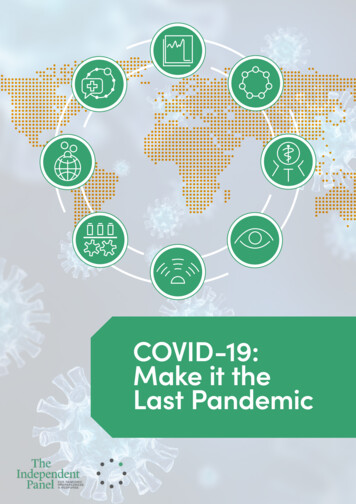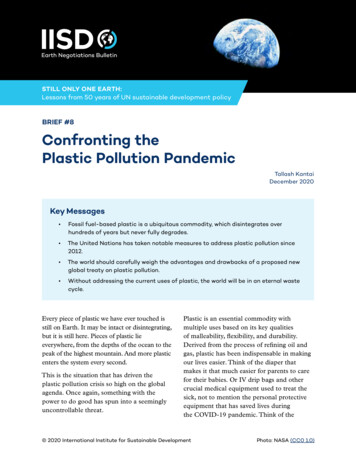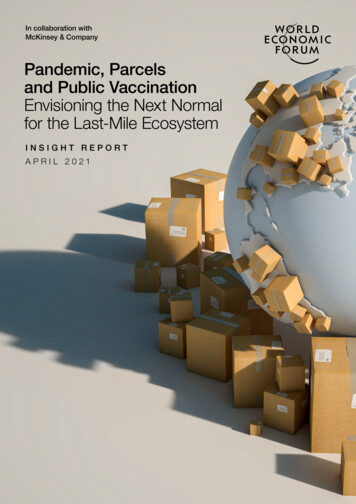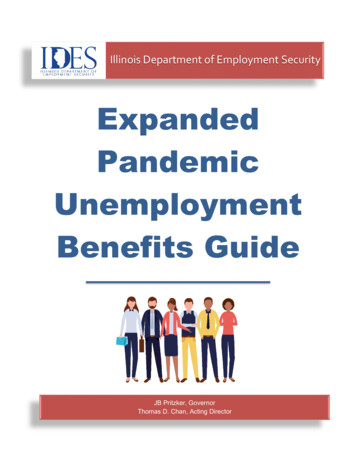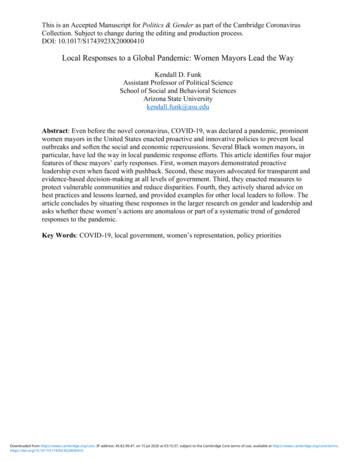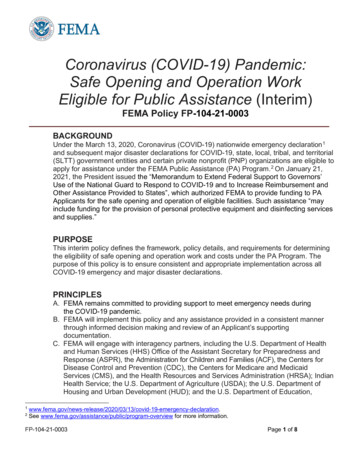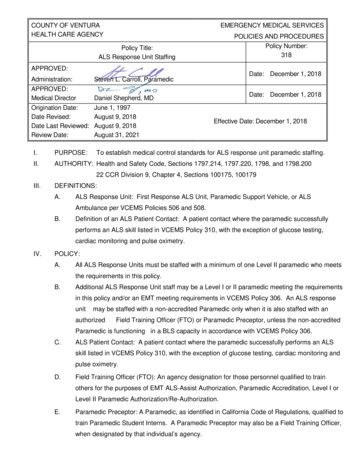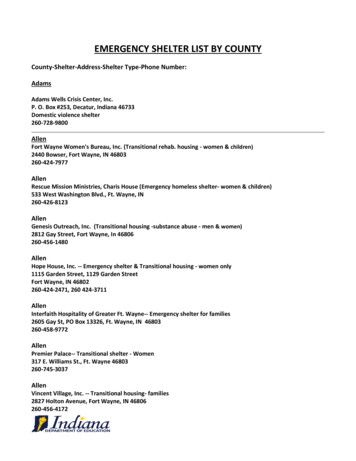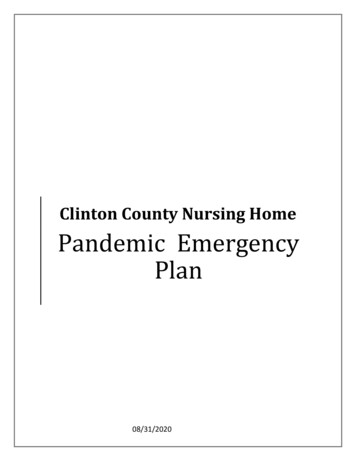
Transcription
Clinton County Nursing HomePandemic EmergencyPlan08/31/2020
ADMINISTRATIVE MANUAL OF POLICIES AND PROCEDURESDEPARTMENT: INTERDISCIPLINARYEFFECTIVE DATE: 8/2020NEW:REVISED:PREPARED BY:APPROVED BY:SUBJECT: Infectious Disease PandemicPOLICY:PROCEDURE:BACKROUND: Infectious diseases are caused by pathogenic microorganisms, such as bacteria, viruses,parasites or fungi. The circumstances of infectious disease emergencies vary by multiple factors,including type of biological agent, scale of exposure, mode of transportation and intentionality.POLICY: Clinton County Nursing Home (CCNH) will follow guidelines and recommendations formanaging an infectious disease pandemic.CCNH will conduct education, surveillance and infection control and prevention strategies to reduce therisk of transmission of infectious disease. CCNH will implement actions according to CDC, NYSDOH andWorld Health Organization recommendations including identification, isolation and informing HealthDepartment, residents and resident representatives of any infectious disease identified as a pandemic.Surveillance:1. Infection Preventionist conducts active surveillance for infectious diseases and reportsactivity in the facility.2. The Infection Preventionist maintains communication and collaborates with local andstate health authorities.3. CCNH will utilize a surveillance line list to track infectious diseases.4. The interdisciplinary team will discuss/review any infectious diseases and review hesurveillance Line List routinely during a pandemic.5. Any concerns relating to infectious diseases will also be discussed with the MedicalDirector and the Clinton County Health Department and/or the NYS Department ofHealth.Outbreak Precautions1. The facility will designate an isolation area (physical therapy room and/or room217) to cohortresidents. Roommates of any resident that has been exposed to potential infectious diseaseduring a pandemic will remain in their room in isolation for the recommended amount of time.2. Staffing assignments, will be made to the extent possible, to maintain separate assignments tomake every effort possible to reduce the number of staff caring infected cohort. Staff caring forinfected cohorts, will bundle care and plan the order of care to minimize the need to go back andforth between cohorts, especially from infected cohort to others. Personal Protective Equipment(PPE) should always be changed before leaving the infected cohort.3. Infection control precautions will be implemented according to the recommendations forthe specific infectious disease. In addition identified infectious prevention precautions
that are identified (droplet, contact, etc.) standard precautions will be used with allresidents regardless of symptoms.4. Recommended precautions will remain in effect for the recommended period of time forthe identified infectious disease. Precautions may be continued for longer periods basedon clinical judgment.5. Any resident that presents with the infectious disease symptoms, will be providedappropriate PPE to don if tolerated and be moved using the shower stretcher to thedesignated isolation area (physical therapy room/room 217) as soon as possible beingcareful not to expose other residents and staff during the transfer. The isolation roomdoor will remain closed and signs indicating appropriate precautions (i.e. contact,droplet precautions) will be posted. Only dedicated personnel should enter the roomutilizing appropriate PPE.6. Promptly notify infection prevention personnel, the Clinton County Health Departmentand the New York State Department of Health (DOH). Consultation with providers willdetermine whether a resident should remain in isolation/quarantined.7. The Clinton County Health Department and the NYS Department of Health should benotified immediately regarding any residents with clinical presentations relating to ainfectious disease pandemic.8. Ensure rapid triage and isolation of residents with symptoms identified as part of aninfectious disease pandemic: Implement triage procedures for symptomatic residents Ensure use of PPT and place in isolation (the physical therapy room/room 217).9. Provide supplies such as 60%-95% alcohol-based hand sanitizer (ABHS), tissues, no touchreceptacles for disposal, and facemasks at entrances, common areas, nurses’ desk, etc.10. Residents who require hospitalization should be transferred as soon as is feasible. CCNH willcohort residents with suspected infectious disease.11. Only designated staff will provide care to residents with suspected infectious diseaseidentified as pandemic in order to minimize the number of staff who enter the room.12. Staff entering the room soon after a resident vacates the room should use appropriateprecautions until the room is terminally cleaned.13. Use dedicated or disposable noncritical resident-care equipment (e.g., blood pressure cuffs).If equipment will be used for more than one resident, clean and disinfect such equipmentbefore use on another resident.14. Staff should perform hand hygiene using ABHS before and after all patient contact, contactwith potentially infectious material, and before putting on and upon removal of PPE,including gloves. Hand hygiene can also be performed by washing with soap and water for atleast 20 seconds. If hands are visibly soiled, use soap and water before returning to ABHS.Ensure that hand hygiene supplies are readily available in every care location.
15. Staff who develop infectious disease symptoms while on duty should not interact with anyresidents and report to the RN Supervisor. Symptomatic staff may not return to work untilthe recommended isolation/quarantine identified by CDC and/or NYS DOH.Visitor Access1. Restriction of non-essential visitation and movement within the facility will be considered atthe discretion of the facility. For a pandemic, the facility will be closed to visitors, except forimminent end-of-life situations.2. It is required to post visual alerts (e.g., signs, posters) at the entrance and in strategic places(e.g. lobby, lounges, employee/service entrance door) to provide residents and staff withinstructions about hand hygiene, respiratory hygiene, screening process and cough etiquette.Instructions should include how to use facemasks or tissues to cover nose and mouth whencoughing or sneezing, to dispose of tissues and contaminated items in waste receptacles, andhow and when to perform hand hygiene.3. All visitors are instructed to follow proper respiratory hygiene and cough etiquette.4. Visits are scheduled and controlled to allow for screening visitors for symptoms of infectiousdisease related to the pandemic before entering the facility.5. Visitors are instructed on hand hygiene and use of personal protective equipment (PPE)while in the resident's room and shall remain in the resident’s room at all times.PROCEDURE:Identifying symptoms of the infectious disease related to the pandemic:1. If a resident presents with symptoms they should be isolated immediately and staff are to useappropriate infection control precautions. The following should be implemented:A. Wear appropriate personal protective equipment (PPE) -including gloves, gown, mask and eyeprotection as recommended by the CDC and NYSDOH for the pandemic.B. Apply appropriate PPE on the symptomatic resident if tolerated.C. If the resident is not ambulatory, transfer resident to a shower stretcher to move the residentto physical therapy room/room217 (designated isolation area). Ensure the isolation roomdoor is closed and appropriate infection control precautions signage is on the door. Limit entryto the designation room.D. Contact the Clinton County Health Department 518-565-4840 to notify them of the suspectedinfection and follow their recommendations.E. Should it be determined that the facility cannot meet the needs of the resident, arrange fortransfer to CVPH Medical Center. Inform the transporting personnel (Ambulance, Varins,WeCare) that resident may have an infectious disease that requires infection precautions.
F. Alert University of Vermont (CVPH Medical Center) that resident requires infectionprecautions related to the pandemic.G. Inform and reassure resident and resident representative that hospital evaluation is required.H. Notify NYS Department of Health, as well as residents and resident representatives that wehave identified a resident as having infectious disease related to the pandemic. Do not disclosepersonally protected information about the resident (do not violate HIPAA).I. Following the resident transfer, keep isolation room door closed for 4 -6 hours and theninitiate terminal room cleaning with EPA approved disinfectant that includes labeling thatincludes coverage for emerging viruses.J. The facility will follow all NYSDOH and CDC updates and guidance regarding the infectiousdisease pandemic.
ADMINISTRATIVE MANUAL OF POLICIES AND PROCEDURESDEPARTMENT: INTERDISCIPLINARYEFFECTIVE DATE: 8/2020PREPARED BY:APPROVED BY:NEW:REVISED:POLICY: PROCEDURE:SUBJECT: STANDARD OPERATING GUIDELINES (SOG) Infectious DiseasePURRPOSE: To establish a Standard Operating Guideline (SOG) for an infectious disease pandemic.SCOPE: This Standard Operating Guideline will apply to all staff.PROCEDURE:A. MITIGATION Existing emergency plans will be reviewed on a regular basis, but no less thanannually. Conduct drills/exercises to test the facilities response to a pandemic thatincludes personnel as well as local, regional, state and private sectorpartners.B. PREPAREDNESS Designate an area in the building where it will be possibleto safely house any residents presenting symptoms of th ein f ec t io u s d isea se . Prompt detection and effective triage and isolation ofpotentially infectious residents is essential to preventunnecessary exposures among residents, healthcarepersonnel, and visitors (when visitation is allowed) at thefacility. As soon as possible, complete training for clinical staffregarding infection control procedures. Validate that staffunderstand and will adhere to infection controlrequirements. Identify staff that will care for symptomatic residents (skilled in infectioncontrol). CCNH will maintain a 60 day supply of infection controlpersonal protective equipment and supplies. Ensure thatPPE is secured within the facility. Supervisors should haveaccess to PPE for needs after business hours.
Contact Office of Emergency Management (OEM) and NYSDOH to request PPE supplies should the regular resources(vendors and suppliers) not be able to meet our needs. Have a plan for supplemental staff should we have staff whobecome sick or are quarantined. (refer to contingency staffingplan in the Comprehensive Emergency Management Plan.) Establish a procedure to update families. Implement staffing policies to minimize the number of staffwho enter the room.C. INDIVIDUAL/EMPLOYEE/ STAFF SCREENING All individuals entering the facility will be screened forsymptoms related to the pandemic. Employees will be required to complete a screening andacknowledge that they will immediately report anysigns and symptoms related to the pandemic to theirsupervisor, Administrator and that they received CDChandouts related to infection preventing anddonning/doffing PPE. An employee presenting symptoms whileondutywill: Avoid contact with any residentsand report to an RN supervisorfor evaluation; If instructed to leave the facilityimmediately, the employee willself-isolate at home, and contacthis/her physician; Inform the facility infectionpreventionist and includeinformation on individuals,equipment, and locations theperson came in contact with; Contact and follow the localhealth departmentrecommendations for nextsteps;D. CLINICAL PRESENTATION Will be identified through the CDC, CMS and/or the NYS DOH
E. OUTBREAK RESPONSE Appropriate infection control precautions related to thepandemic will be implemented during care of symptomaticresidents, in addition to standard precautions used with allresidents regardless of symptoms. Infection control precautions will be continued for as longas recommended by the CDC, CMS and/or the NYS DOH.Precautions may be continued for longer periods based onclinical judgment. The Clinton County Health Department and the NYSDepartment of health should be notified immediately tonotify them of resident’s who are suspected to theinfectious disease related to the pandemic. Staff who develop symptoms are to report to an RNSupervisor. Staff should not come into contact with anyresident or other staff until the RN determines if they need toleave the facility. Symptomatic staff may not return to workuntil the recommend time has lapsed for the identifiedinfectious disease related to the pandemic. Symptomatic residents should be isolated in the identifiedisolation room with the door closed. Only essential personnelshould enter the room. Designate staff to minimize the number of individuals whoenter the room. Staff entering the room soon after a resident vacates the roomshould use identified PPE related to the infectious disease. Staff should perform hand hygiene using ABHS before and afterall resident contact, contact with potentially infectiousmaterial, and before putting on and upon removal of PPE,including gloves. Hand hygiene in healthcare settings also canbe performed by washing with soap and water for at least 20seconds. If hands are visibly soiled, use soap and water beforereturning to ABHS.
ADMINISTRATIVE MANUAL OF POLICIES AND PROCEDURESDEPARTMENT: INTERDISCIPLINARYPREPARED BY:APPROVED BY:EFFECTIVE DATE: 8/2020NEW:REVISED:POLICY: PROCEDURE:SUBJECT: Resident/Resident Representative Communication PlanPolicy:It is the policy of Clinton County Nursing Home (CCNH) to ensure families and staff are made aware ofinfectious disease relating to a pandemic if it is identified at the nursing home.Communication: Contact information Resident contact information will be maintained it PointClickCareStaff contact information will be maintained in the Comprehensive EmergencyManagement Plan booksIf a resident or staff member is symptomatic or tests positive for and infectious disease: If a resident or staff member is positive for the identified infectious disease, contact theDirector of Nursing and the Administrator as soon as possible.The Director of Nursing and/or the Infection Preventionist or designee will immediatelynotify the following:o Clinton County Health Departmento New York State Department of HealthThe Director of Nursing or the Infection Preventionist or their designee will contact theresident representative of the resident to alert them of their positive infectious disease.The Director of Nursing or the Infection Preventionist or their designee will provideupdates to the resident representative of the residents that are infected with the infectiousdisease relating to the pandemic at least once per day and upon change in the residentscondition.If a staff member tests positive, the Director of Nursing or the Infection Preventionist ortheir designee will notify them and alert them to any quarantine required by the pandemic.The Unit Managers or their designee will notify all residents and resident representativesof the positive case (either resident or staff) and will assure privacy is not violated(HIPAA). Thereafter, information will be distributed to residents weekly, either byannouncement, posting on bulletin board or in person.Resident Representatives will be updated weekly via email once per week statistics on thenumber of residents and/or staff infections and if there are any associated deaths.In the event that visitation is restricted due to an infectious disease pandemic:CCNH will ensure there are opportunities for residents to communicate with their loved ones by offeringthe following: FaceTime Zoom Telephone calls Window Visits
Clinton County Nursing HomePandemic MemoFor the health and welfare of ourresidents we are limiting visitation andasking that if you have any symptomsrelated to the pandemicPLEASE REFRAIN FROM ENTERING AT THISTIME.We are discouraging visitation after businesshours when the receptionist is gone. Pleasecall the facility to determine eligibility forvisitation.ALL INDIVIDUALS WHO ENTER THE NURSINGHOME MUST BE SCREENED FOR THESYPMTOMSRELATIGNTOTHEPANDEMIC.Thank you for your understandingand cooperation as we protect ourresidents.
ATTENTIONALL VISITORSIf you have fever, shortness of breath, cough, nasal congestion,runny nose, sore throat, nausea, vomiting and/or diarrhea.DO NOT VISITDO NOT VISITUntil you are completely recovered.Infections like flu and novel coronavirus (COVID-19) are especiallydangerous to the residents and can be avoided.13066 (Nursing Homes)
Inform the transporting personnel (Ambulance, Varins, WeCare) that resident may have an infectious disease that requires infection precautions. F. Alert University of Vermo
